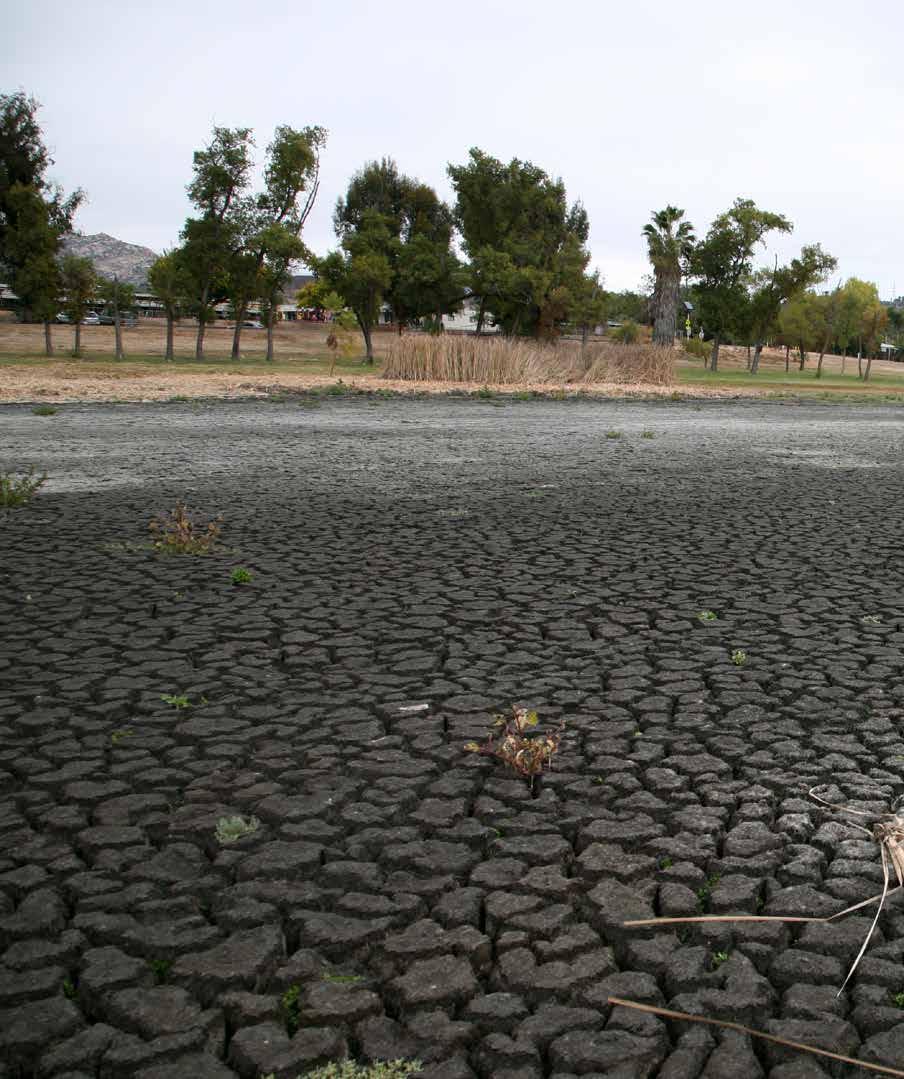
13 minute read
Meeting the Challenge of Climate Change
Meeting the Challenge of
CLIMATE CHANGE
Advertisement
Climate change is changing the way parks are planned, designed, managed and programmed
By Richard J. Dolesh
On any given day in any given park across the United States, climate change may not seem like a big deal. Sure, there may be some parks that are flooded somewhere and there may be some parks on fire elsewhere, but by and large, the vast public trust of our local, state and national parks is in good shape. However, it is also true that virtually every park in every state in every locality is facing an existential threat from a rapidly changing climate.
CLIMATE CHANGE
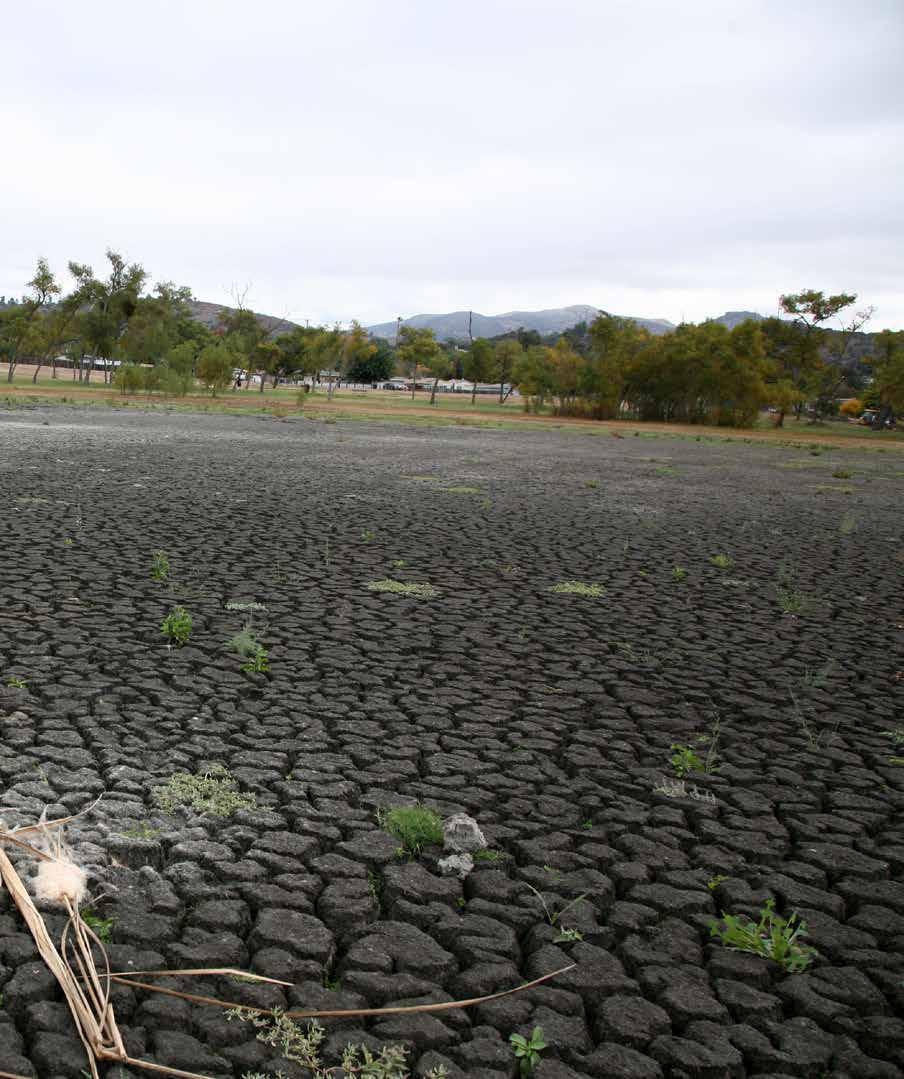
According to the World Meteorological Organization (WMO), which tracks multiple datasets of global weather records, the past seven years have been the hottest years ever recorded. Every decade since 1980 has been hotter than the previous one, and that trend is expected to continue for decades to come despite all efforts to mitigate increasing temperatures. Long-term warming trends are now greater than the annual variability in global average temperatures of natural climate cycles. A new technical report on sea level rise issued by the National Oceanic and Atmospheric Administration (NOAA) in February 2022, states that by 2050, damaging tidal and coastal flooding will be 10 times more likely on average than it is today.
In addition to warming temperatures and rapidly accelerating sea level rise, 2021 saw 20 $1 billion weather disasters, second only to 2020, which had 22 $1 billion events. These included extreme rains and floods, intense winter storms, hurricanes, droughts, heat waves, wildfires, and wide-spread derechos, or wind events, according to NOAA. Paradoxically, a rapidly warming climate does not mean that it will just continue to get hotter, but rather that weather and climate cycles will become more unpredictable and more severe. Importantly, those who are least able to withstand these extremes will be most vulnerable to them. “Climate change impacts and weather-related hazards have had life-changing and devastating impacts” on communities everywhere, according to WMO Secretary General Petteri Taalas.
There are many indirect effects of climate change as well. While causal links are not yet fully proven, they are highly indicative of being climate related. Threebillion birds have disappeared from North America in the past 30 years, nearly one-third of all birds (tinyurl.com/fudwssda). The coming of the so-called “insect apocalypse,” in which insect populations that are foundational to ecosystem health will crash, has been documented already in certain areas of Europe where the abundance and diversity of insect species have declined 75 percent in less than 30 years. Along with these factors indirectly attributed to climate change are the explosion of invasive species; increases in human health risks from extreme heat, drought, air pollution and floods; and the accelerating loss of biodiversity in developed areas and natural landscapes.
Whether park and recreation leaders have planned sufficiently to anticipate future conditions or not, the pace of climate change will now affect every aspect of the field, from park planning to park design to park management to recreation programming. When viewed as strategic assets of cities and counties in adapting to the impacts of climate change, parks serve vital functions — as buffers to extreme heat, storage areas for stormwater, refuges of biodiversity, and places of respite to maintain human health. As the pace of climate change accelerates, parks can no longer be just singlepurpose public amenities. Parks must become multi-benefit assets to their immediately surrounding communities and the regions they are in.
REPORT COVER COURTESY OF SEATTLE PARKS AND RECREATION; COVER IMAGE BY SHUTTER RUNNER, CC BY-NC 2.0, TINYURL.COM/YCKAV5YB
The Role of Parks
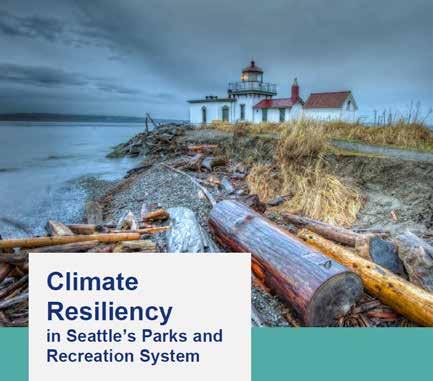
What are the greatest threats from climate change right now? “You cannot really single out one standalone factor,” says David Rouse, former research director for the American Planning Association and co-author
The Seattle Parks and Recreation (SPR) climate resiliency report can serve as a model for any agency’s climate resilience planning. The photo shows The West Point Light located on the shore of SPR’s Discovery Park in Puget Sound.
of the highly acclaimed book, The Comprehensive Plan: Sustainable, Resilient, and Equitable Communities for the 21st Century. “Heat is probably the greatest threat. It will be impossible to go outside in some areas of the country during the heat of the summer,” he says. “And drought is the companion to extreme heat.”
Other experts identify related threats, such as sea level rise and flooding or violent storms, depending on which areas of the country are being affected. “Communities need to look at a spectrum of the most critical threats and be prepared to deal with the shocks of single events and the endemic effects of long-term stresses as they occur,” Rouse continues. “But the greatest of threat[s] from climate change [are] inequality and a lack of equity. Parks cannot solve this alone.”
In San Diego County, Brian Albright, director of parks and recreation, says, “For us, the greatest threats are extreme heat and wildfires. When viewed in the context of our recent history over the last 25 years, heat and wildfires are changing the very nature of our parks and open space areas. For example, after wildfires, what comes back is not necessarily what was there before or even what we want to see in the landscape. We are restoring our forests with the right mix of trees and vegetation to be sure we reduce community heat islands and manage stormwater throughout the landscape.”
Ignacio Bunster-Ossa, vice president of landscape urbanism and resilience at The Collaborative in Philadelphia, has been called one of America’s leading landscape architects and urban designers. He says, “The problem is that climate change is not urgent in most people’s minds. Park designers and planners need to become advocates, too. We have the responsibility to put the facts before elected officials and funders. It is up to us to say, ‘Here are ways we can address the problem.’ The changes are inevitable and will only happen at a faster rate in the future.”
“What should a park be?” asks Bunster-Ossa. “We are at a point of inflection. Are parks just lawns and trees, landscaped areas, and recreation amenities, or are they something more? In the face of climate change, parks must become something more. We must be looking at the entire system, and it is going to have to change.”
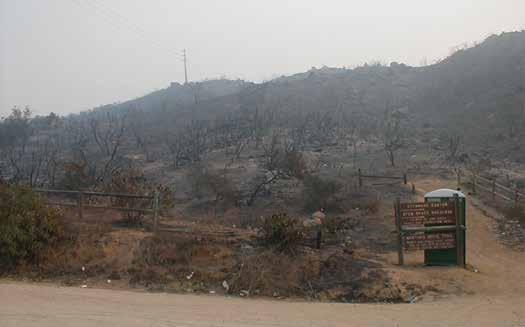
Systems Thinking
Maria Nardi, director of MiamiDade County Department of Parks, Recreation and Open Spaces, agrees that a holistic view of their entire park and recreation system is critical. “We have to look at every part of our system and how we connect blueways and greenways and streets and communities. We must understand the impacts of climate change to the entire system, not just to the individual pieces. This also helps us understand how our park system shapes the entire county and region and how it builds the health of individual communities.”
Signe Nielsen, landscape architect, founding principal of Mathews Nielsen Landscape Architects and designer of Little Island, a unique waterfront park over the Hudson River in New York City, says that without question, parks will be seen as strategic assets in responding to the impacts of climate change. “As Mitch Silver [former director of New York City Department of Parks and Recreation] frequently says, ‘Parks are critical infrastructure.’ I am a huge supporter of that belief. In terms of health and equity, quality parks are vital, especially to those who are most vulnerable.”
Without exception and across disciplines, experts in landscape architecture, comprehensive planning and park design believe it is absolutely necessary to plan and act now.
“I believe the most important thing we need to address regarding climate change is to plan,” says Jason Hellendrung, vice president of planning and design for Tetra Tech, an international engineering and consulting firm. “So often, agencies and municipalities are not doing the planning that will be necessary to meet the challenges of climate change. A part of this planning is looking at what your vulnerabilities to climate change are and where to make investments. This is where a large measure of urgency needs to be.”
Many national corporations, including financial and insurance companies, are engaging analytics firms to conduct climate-risk forecasting to better quantify the physical, economic and transition risks of climate change. While some cities, counties and municipal governments have begun to engage in developing climate-risk scenarios, few park and recreation agencies have done so to this point, despite mounting evidence of substantial climate risk to parks, facilities, shorelines and built infrastructure. The reasons why agencies have not begun to plan for climate risk are many — a lack of urgency, competing priorities, insufficient budget, and worse, the unwillingness to see the gravity of the risks.
Seattle Parks and Recreation is a good example of an agency that is taking climate change planning seriously. Its report, Climate Resiliency in Seattle’s Parks and Recreation System (tinyurl.com/78x9ber8), released in January 2022, is an excellent model for how park and recreation agencies can assess vulnerabilities, evaluate possible climate scenarios, and prioritize resources and courses of action for budget planning and policy direction.
PHOTO COURTESY OF IGNACIO BUNSTER-OSSA/THE COLLABORATIVE Pergolas sit along Georgetown’s waterfront in Washington, D.C. The vines planted to grow up and over them for shade “were a little harder to train than we originally thought,” says landscape architect Ignacio Bunster-Ossa.
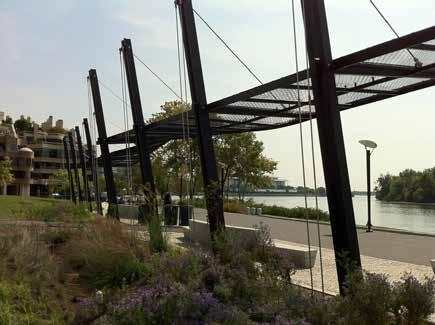
Matheson Hammock Park
PHOTO COURTESY OF MIAMI-DADE PARKS, RECREATION AND OPEN SPACES 5. The areas in red show the extent of so-called “sunny-day flooding” from king tides in MiamiDade’s Matheson Hammock Park.
Finding Solutions
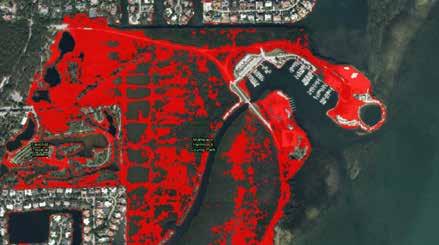


In Hampton, Virginia, nuisance flooding and sea level rise are serious climate change threats. Carolyn Heaps, resiliency officer for the city, says they are currently updating their park master plan to integrate resilience and climate adaptation features along with other priorities. “We are looking at the realities of the future,” she says. Scott Smith, senior civil engineer for the city, says, “As an older urban city that is largely built out and subject to recurrent flooding from sea level rise, we don’t have a lot of spaces to store stormwater. We have to come up with innovative ways to create new stormwater storage and the handling of floodwaters.”
To prove this concept, the city is applying innovative green infrastructure principles to retrofit Honor Park, a memorial park near city hall, which honors fallen heroes of Hampton. The city’s goal is to create additional stormwater capacity in a developed urban area. Engineering consultants Brown and Caldwell suggested constructed wetlands, a stormwater overflow area into an amphitheater, and bioretention cells to slow and hold water, along with tree plantings, benches and special soil amendments. “This is a pilot for us, that if successful, will show what can be done in other parks and public areas,” says Smith.
They are applying the same principles to the retrofitting of Big Bethel Blueway, a largely overgrown stormwater floodway. “Water quality is a priority for us as well,” says Heaps. “In both parks, we are meeting the regulatory goals for water quality and getting mul-
A concept plan for the redesign of Honor Park in Hampton, Virginia, utilizes green infrastructure principles to slow, retain and infiltrate stormwater coming into the park from city streets.
tiple other benefits, including additional stormwater storage capacity, biodiversity protection and public recreation access.”
Reducing the Impacts of Climate Change
One of the most immediate challenges facing park designers and managers is providing enough shade to reduce the impacts of extreme heat. Whether it is for activity areas in new parks or existing parks, the challenge of providing sufficient shade is vexing park managers in virtually every area of the country. “Due to the extreme heat that we are seeing during our summers, we have been incorporating shade structures into any new or replacement playgrounds,” says Bill Offutt, park operations manager for Anne Arundel County Parks and Recreation in Maryland. Mike Shull, general manager of the City of Los Angeles Department of Recreation and Parks, says, “We can build a million-dollar playground and unless it has shade, no one will use it during the heat of the day.”
In planning parks, “One of our first considerations is what does the community need?” says Nielsen. “What is the context of the site? What risks is the site subjected to? For us, in New York City, it is drought, heavy rains and extreme heat. Those are our givens. We look at how we can employ green infrastructure principles in design and construction and how we can make the park more resilient. In retrofitting parks, we think about adding more trees, increasing the diversity of plant species, and whether there can be better rain and stormwater capture. Managing stormwater in parks is often a missed opportunity. If possible, we think about alternative and renewable energy sources, such as solar, and especially, we think how we can add shade, man-made or natural.”
Martha Schwartz, noted urban design expert and professor in practice in landscape architecture at the Harvard University Graduate School of Design, says that we must look at our cities and urban areas as working ecological systems. “When we understand what the land can do, it is amazing. Cities must expand the amount of open space within their boundaries. Working ecosystems are based on interconnectivity. The best way we can connect our natural spaces and parks is through interconnected urban forests, not just a bunch of trees planted in a line.”

PHOTO COURTESY OF WAGGONNER & BALL ARCHITECTURE/ ENVIRONMENT
The Cost of Inaction
Schwartz asks, “What is the cost of climate change? If we commit to the costs [of adaptation and mitigation] now, it will cost a lot more than business as usual. If we wait, however, it will cost an insane amount of money.”
In addition to forecasting the risks to natural systems and the built environment, we need to understand the risks to human health. While the effects of extreme heat exposure to adults are well documented, a new meta-analysis in the January 2022 issue of Environmental Health Perspectives reports that in an analysis of 4 million emergency room visits of children to 47 hospitals during 2016 to 2018, treatment for heat stressrelated illnesses in children and youth was nearly one-third higher than for adults and up to one-quarter higher than adults for bacterial intestinal infections (tinyurl.com/2s4zz5pn). These disproportionately higher rates of certain illnesses in children and youth represent a new threshold in understanding the health impacts of climate change on children. An equal measure of concern must be given to those who are most vulnerable to these stresses, including low-income communities, minority populations, children, older adults and those who must work outdoors in extreme heat, including our own park and recreation workers.
Schwartz says, “Parks are not an amenity anymore. They are an absolute necessity. We must look at the risks we face. We have solutions and we can live in balance with nature. Parks will be a critical part of the solution.” Nardi says, “Parks are being seen more and more as the underpinnings of strategies for climate change adaptation and mitigation. Parks are the green heart of our communities.”
Richard J. Dolesh is NRPA’s retired Vice President of Strategic Initiatives and Editor-at-Large for Parks & Recreation magazine (dolesh@gmail.com).


